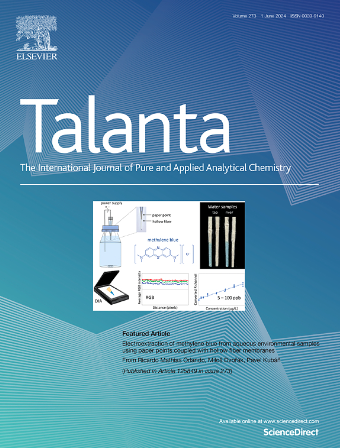惰性重塑策略构建用于比色-化学发光成像双模级联酶传感的双金属受限氮掺杂碳纳米酶
IF 6.1
1区 化学
Q1 CHEMISTRY, ANALYTICAL
引用次数: 0
摘要
大气中金属有机框架(mof)衍生的纳米酶在生物传感领域备受关注。然而,这种衍生模式可能导致MOF框架的不稳定和活性位点的聚集,从而降低其催化活性。在此,我们报道了一种惰性重塑策略来构建双金属限制氮掺杂碳纳米酶用于双模式级联酶生物传感。该策略通过在氩气气氛中热解MOFs (CoNi- zif -67为模型)前驱体,形成CoNi双金属纳米颗粒均匀受限氮掺杂碳(CoNi- cn)纳米酶而容易实现。该衍生物纳米酶的过氧化物酶(POD)样活性显著增强,比NiCo2O4纳米酶(空气中CoNi-ZIF-67衍生物)高4倍,比CoNi-ZIF-67前体高54倍。CoNi - cn纳米酶具有优异的pod样活性,主要归因于以下几个方面:1)具有均匀分散的CoNi双金属活性位点的完整结构;ii) CN结构中封装的CoNi双金属的约束效应。结合葡萄糖氧化酶(GOx)制备CoNi - CN@GOx级联酶,研制了基于CoNi - CN@GOx级联体系的比色-化学发光成像传感器用于葡萄糖检测。葡萄糖在0.08-15 mM(比色法)和0.1-30 mM (CL成像)的宽线性范围内测定。该研究为构建双模式生物传感应用的高性能纳米酶提供了一种有前途的惰性重塑策略。本文章由计算机程序翻译,如有差异,请以英文原文为准。

Inert-remodeling strategy to build bimetal-confined nitrogen-doped carbon nanozyme for colorimetric-chemiluminescent imaging dual-mode cascade enzyme sensing
The metal-organic frameworks (MOFs)-derived nanozymes in air atmosphere have gained great attention in biosensing fields. Nevertheless, this derivative pattern may result in the destabilization of the MOF framework and the aggregation of active sites, consequently diminishing its catalytic activity. Herein, we reported an inert-remodeling strategy to build bimetal-confined nitrogen-doped carbon nanozyme for dual-mode cascade enzyme biosensing. The strategy was easily achieved by pyrolysis of MOFs (CoNi-ZIF-67 as model) precursor in argon atmosphere, leading to the formation of CoNi bimetallic nanoparticles uniformly confined nitrogen-doped carbon (CoNi–CN) nanozyme. This derivative nanozyme exhibits significantly enhanced peroxidase (POD)-like activity, which is 4 times higher than that of NiCo2O4 nanozyme (CoNi-ZIF-67 derivative in air atmosphere) and 54 times higher than that of CoNi-ZIF-67 precursor. The excellent POD-like activity of CoNi–CN nanozyme is ascribed to the following facts: i) integrate structure with uniformly dispersed CoNi bimetal active sites; ii) confinement effect of CoNi bimetal encapsulated in CN architecture. Integrating with glucose oxidase (GOx) to prepare cascade enzyme of CoNi–CN@GOx, colorimetric-chemiluminescent imaging sensor based on CoNi–CN@GOx cascade system was developed for glucose detection. Glucose was assayed in wide linear ranges of 0.08–15 mM (colorimetric) and 0.1–30 mM (CL imaging). This research provides a promising inert-remodeling strategy to construct high-performance nanozyme for dual mode biosensing applications.
求助全文
通过发布文献求助,成功后即可免费获取论文全文。
去求助
来源期刊

Talanta
化学-分析化学
CiteScore
12.30
自引率
4.90%
发文量
861
审稿时长
29 days
期刊介绍:
Talanta provides a forum for the publication of original research papers, short communications, and critical reviews in all branches of pure and applied analytical chemistry. Papers are evaluated based on established guidelines, including the fundamental nature of the study, scientific novelty, substantial improvement or advantage over existing technology or methods, and demonstrated analytical applicability. Original research papers on fundamental studies, and on novel sensor and instrumentation developments, are encouraged. Novel or improved applications in areas such as clinical and biological chemistry, environmental analysis, geochemistry, materials science and engineering, and analytical platforms for omics development are welcome.
Analytical performance of methods should be determined, including interference and matrix effects, and methods should be validated by comparison with a standard method, or analysis of a certified reference material. Simple spiking recoveries may not be sufficient. The developed method should especially comprise information on selectivity, sensitivity, detection limits, accuracy, and reliability. However, applying official validation or robustness studies to a routine method or technique does not necessarily constitute novelty. Proper statistical treatment of the data should be provided. Relevant literature should be cited, including related publications by the authors, and authors should discuss how their proposed methodology compares with previously reported methods.
 求助内容:
求助内容: 应助结果提醒方式:
应助结果提醒方式:


